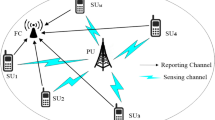Abstract
In order to detect the unused spectrum bands (the spectrum holes) efficiently in cognitive radios with low signal-to-noise radio (SNR), we propose to adopt two independent branches of wavelet to detect the singularities of the received signals’ power spectrum density (PSD). The sensing structure is flexible such that we can use one or two branches to cope with different SNRs. Under low SNR condition, each branch uses distinct characteristics between noise and signals in the wavelet transform to eliminate the singularities generated by the noise. By using bandpass filter to calculate PSD values of the subbands which are distinguished by the signal’s singularities, the subband with the minimum PSD value among all of the subbands could be found. Then, the results of the two branches are merged and analyzed in order to make the final decision. Finally, we use signal reconstruction to further remove the noise and then accurately detect the spectrum holes. When the SNR is high, only one branch through the denoising procedure is needed to get accurate sensing result. Our simulation results show that the two-branch wavelet method is more accurate than conventional approaches under given SNRs.















Similar content being viewed by others
References
Akyildiz, I. F., Lee, W.-Y., Vuran, M. C., & Mohanty, S. (2006). Next generation/dynamic spectrum access/cognitive radio wireless networks: a survey. Computer Networks, 50(13), 2127–2159.
Ariananda, D. D., Lakshmanan, M. K., & Nikooka, H. (2009). A study on the application of wavelet packet transforms to cognitive radio spectrum estimation. In Proceedings of the fourth international conference on CROWNCOM.
Cabric, D., Tkachenko, A., & Brodersen, R. W. (2006). Experimental study of spectrum sensing based on energy detection and network cooperation. In Proceedings of the first international workshop on technology and policy for accessing spectrum.
Haykin, S. (2005). Cognitive radio: brain-empowered wireless communications. IEEE Journal on Selected Areas in Communications, 23(2), 201–220.
Hur, Y., Park, J., & Woo, W. (2006). A cognitive radio (CR) system employing a dual-stage spectrum sensing technique: a multi-resolution spectrum sensing (MRSS) and a temporal signature detection (TSD) technique. In IEEE GLOBECOM.
Kim, S., Yoon, Y., Jeon, H., Kim, M., & Lee, H. (2008). Selective discrete wavelet packet transform-based energy detector for cognitive radios. In IEEE MILCOM.
Lee, W.-Y., & Akyildiz, I. F. (2008). Optimal spectrum sensing framework for cognitive radio networks. IEEE Transactions on Wireless Communications, 7(10), 3845–3857.
Mallat, S., & Hwang, W. L. (1992). Singularity detection and processing with wavelets. IEEE Transactions on Information Theory, 38(2), 617–643.
Mitola, J., & Maguire, G. Q. (1999). Cognitive radio: making software radios more personal. IEEE Personal Communications, 6(4), 13–18.
Sakran, H., & Shokair, M. (2011). Hard and softened combination for cooperative spectrum sensing over imperfect channels in cognitive radio networks. Telecommunication Systems. http://www.springerlink.com/content/h295572211018htv/.
Tang, L., Chen, Q. B., Wang, G. Y., Zeng, X. P., & Wang, H. (2011). Opportunistic power allocation strategies and fair subcarrier allocation in OFDM-based cognitive radio networks. Telecommunication Systems. http://www.springerlink.com/content/g0g56801r0640m4g/.
Tang, Z. H., Wei, G., & Zhu, Y. T. (2009). Weighted sum rate maximization for OFDM-based cognitive radio systems. Telecommunications Systems, 42, 77–84.
Tian, Z., & Giannakis, G. B. (2006). A wavelet approach to wideband spectrum sensing for cognitive radios. In IEEE first international conference on cognitive radio oriented wireless networks and communications.
Wang, W., Wu, K. J., Luo, H. Y., Yu, G. D., & Zhang, Z. Y. (2011). Sensing error aware delay-optimal channel allocation scheme for cognitive radio networks. Telecommunication Systems. http://www.springerlink.com/content/t833p625265p0415/.
Xu, Y.-L., Zhang, H.-S., & Han, Z.-H. (2009). The performance analysis of spectrum sensing algorithms based on wavelet edge detection. In Proceedings of the 5th international conference on wireless communications, networking and mobile computing.
Zhang, Y. H., & Leung, C. (2009). Cross-layer resource allocation for real-time services in OFDM-based cognitive radio systems. Telecommunications Systems, 42, 97–108.
Acknowledgements
This work is supported by Program for Special grade of China Postdoctoral Science Foundation funded project (200902588), as well as National Natural Science Foundation of China (61072069).
Author information
Authors and Affiliations
Corresponding author
Rights and permissions
About this article
Cite this article
Li, X., Hu, F., Zhang, H. et al. Two-branch wavelet denoising for accurate spectrum sensing in cognitive radios. Telecommun Syst 57, 81–90 (2014). https://doi.org/10.1007/s11235-013-9787-x
Published:
Issue Date:
DOI: https://doi.org/10.1007/s11235-013-9787-x




